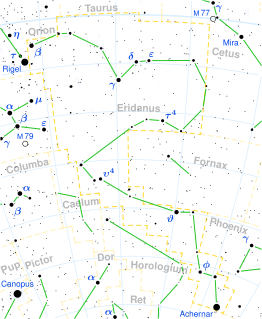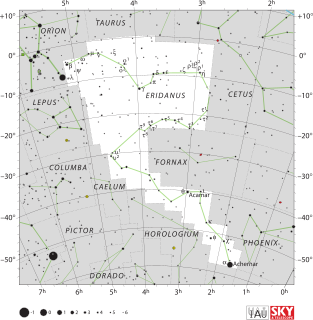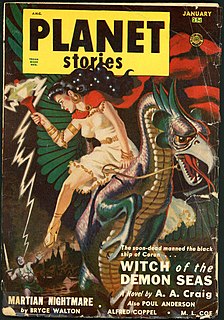Known Space is the fictional setting of about a dozen science fiction novels and several collections of short stories written by Larry Niven. It has also become a shared universe in the spin-off Man-Kzin Wars anthologies. The Internet Speculative Fiction Database (ISFDB) catalogs all works set in the fictional universe that includes Known Space under the series name Tales of Known Space, which was the title of a 1975 collection of Niven's short stories. The first-published work in the series, which was Niven's first published piece was "The Coldest Place", in the December 1964 issue of If magazine, edited by Frederik Pohl. This was the first-published work in the 1975 collection.
Tau Ceti, Latinized from τ Ceti, is a single star in the constellation Cetus that is spectrally similar to the Sun, although it has only about 78% of the Sun's mass. At a distance of just under 12 light-years from the Solar System, it is a relatively nearby star and the closest solitary G-class star. The star appears stable, with little stellar variation, and is metal-deficient.

Epsilon Eridani, formally named Ran, is a star in the southern constellation of Eridanus, at a declination of 9.46° south of the celestial equator. This allows it to be visible from most of Earth's surface. At a distance of 10.5 light-years from the Sun, it has an apparent magnitude of 3.73. It is the third-closest individual star or star system visible to the unaided eye.
CoDominium is a series of future history novels written by American writer Jerry Pournelle, along with several co-authors, primarily Larry Niven.
40 Eridani, also designated Omicron² Eridani, is a triple star system in the constellation of Eridanus. Based on parallax measurements taken during the Hipparcos mission, it is less than 17 light-years from the Sun.
82 G. Eridani is a star about 20 light years away from Earth in the constellation Eridanus. It is a main-sequence star with a stellar classification of G6 V, and it hosts a system of at least three planets and a dust disk.
Luyten 726-8, also known as Gliese 65, is a binary star system that is one of Earth's nearest neighbors, at about 8.7 light years from Earth in the constellation Cetus. Luyten 726-8B is also known under the variable star designation UV Ceti, being the archetype for the class of flare stars.

Eridanus is a constellation in the southern celestial hemisphere. It is represented as a river. One of the 48 constellations listed by the 2nd century astronomer Ptolemy, it remains one of the 88 modern constellations. It is the sixth largest of the modern constellations, and the one that extends farthest in the sky from north to south. The same name was later taken as a Latin name for the real Po River and also for the name of a minor river in Athens.

Iota Horologii, Latinized from ι Horologii, is a yellow-hued star approximately 56.5 light-years away in the Horologium constellation. The star is classified as a G0Vp yellow dwarf. It has a mass and radius larger than the Sun, and is about 50% more luminous.

Margaret Carol "Maggie" Turnbull is an American astronomer and astrobiologist. She received her PhD in Astronomy from the University of Arizona in 2004. Turnbull is an authority on star systems which may have habitable planets, solar twins and planetary habitability. She is also an expert on the use of the coronagraph in the direct detection of exoplanets.
The planetary systems of stars other than the Sun and the Solar System are a staple element in many works of the science fiction genre.

The Stones of Nomuru is a science fiction novel by American writers L. Sprague de Camp and Catherine Crook de Camp, the tenth book in the former's Viagens Interplanetarias series and the first in its subseries of stories set on the fictional planet Kukulkan. It was first published as a trade paperback by Donning/Starblaze Editions in September 1988, and as a mass market paperback by Baen Books in May 1991. An E-book edition was published by Gollancz's SF Gateway imprint on September 29, 2011 as part of a general release of de Camp's works in electronic form. It has also been translated into Italian.

Epsilon Eridani b, also known as AEgir [sic], is an exoplanet approximately 10.5 light-years away orbiting the star Epsilon Eridani, in the constellation of Eridanus. The planet was discovered in 2000, and as of 2022 remains the only confirmed planet in its planetary system. It orbits at around 3.5 AU with a period of around 7.4 years, and has a mass around 1.2 times that of Jupiter.
Epsilon Tauri b (abbreviated ε Tauri b or ε Tau b), formally named Amateru, is a super-Jupiter exoplanet orbiting the K-type giant star Epsilon Tauri approximately 155 light-years (47.53 parsecs, or nearly 1.466×1015 km) away from the Earth in the constellation of Taurus. It orbits the star further out than Earth orbits the Sun. It has moderate eccentricity.
HD 10647 b, also catalogued as q1 Eridani b, is an extrasolar planet approximately 57 light-years away in the constellation of Eridanus. The planet is a mid-Jovian that orbits 103% farther from the star than Earth to the Sun. It takes about 33 months to orbit with semi-amplitude of 17.9 m/s.

The Venom Trees of Sunga is a science fiction novel by American writer L. Sprague de Camp, the twelfth book in his Viagens Interplanetarias series and the second in its subseries of stories set on the fictional planet Kukulkan. It was first published in paperback by Del Rey Books in November 1992. An E-book edition was published by Gollancz's SF Gateway imprint on September 29, 2011 as part of a general release of de Camp's works in electronic form.

Murasaki is a 1992 "shared universe" hard science fiction novel in six parts to which Poul Anderson, Greg Bear, Gregory Benford, David Brin, Nancy Kress and Frederik Pohl each contributed one chapter; it was edited by Robert Silverberg. It is the first anthology of this type to be entirely conceived and written by winners of the Nebula Award.

The Star Fox is a science fiction novel by Poul Anderson, first published in 1965. It was nominated for the Nebula Award for Best Novel in 1965.

The Enemy Stars, is a science fiction novel by American writer Poul Anderson, published in 1959 by J.B Lippincott in the US and by Longmans in Canada. Originally published in Astounding Science Fiction under the title We Have Fed Our Sea__, it was a nominee for the 1959 Hugo Award for Best Novel. The original title refers to a line in a poem by Rudyard Kipling.

The following is a list of works by science fiction and fantasy author Poul Anderson.











